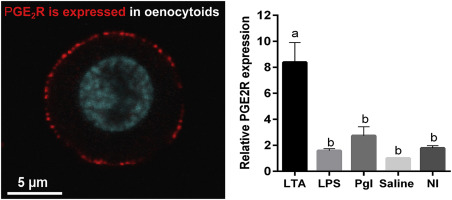当前位置:
X-MOL 学术
›
Insect Biochem. Mol. Biol.
›
论文详情
Our official English website, www.x-mol.net, welcomes your
feedback! (Note: you will need to create a separate account there.)
Characterization of the first insect prostaglandin (PGE2) receptor: MansePGE2R is expressed in oenocytoids and lipoteichoic acid (LTA) increases transcript expression.
Insect Biochemistry and Molecular Biology ( IF 3.2 ) Pub Date : 2019-11-29 , DOI: 10.1016/j.ibmb.2019.103290 Hyeogsun Kwon 1 , Yunlong Yang 1 , Sunil Kumar 2 , Dae-Weon Lee 1 , Prati Bajracharya 1 , Travis L Calkins 1 , Yonggyun Kim 2 , Patricia V Pietrantonio 1
Insect Biochemistry and Molecular Biology ( IF 3.2 ) Pub Date : 2019-11-29 , DOI: 10.1016/j.ibmb.2019.103290 Hyeogsun Kwon 1 , Yunlong Yang 1 , Sunil Kumar 2 , Dae-Weon Lee 1 , Prati Bajracharya 1 , Travis L Calkins 1 , Yonggyun Kim 2 , Patricia V Pietrantonio 1
Affiliation

|
In arthropods, eicosanoids derived from the oxygenated metabolism of arachidonic acid are significant in mediating immune responses. However, the lack of information about insect eicosanoid receptors is an obstacle to completely decipher immune mechanisms underlying both eicosanoid downstream signal cascades and their relationship to immune pathogen-associated molecular patterns (PAMPs). Here, we cloned and sequenced a G protein-coupled receptor (MW 46.16 kDa) from the model lepidopteran, Manduca sexta (Sphingidae). The receptor shares similarity of amino acid motifs to human prostaglandin E2 (PGE2) receptors, and phylogenetic analysis supports its classification as a prostaglandin receptor. In agreement, the recombinant receptor was activated by PGE2 resulting in intracellular cAMP increase, and therefore designated MansePGE2R. Expression of MansePGE2R in Sf9 cells in which the endogenous orthologous receptor had been silenced showed similar cAMP increase upon PGE2 challenge. Receptor transcript expression was identified in various tissues in larvae and female adults, including Malpighian tubules, fat body, gut and hemocytes, and in female ovaries. In addition to the cDNA cloned that encodes the functional receptor, an mRNA was found featuring the poly-A tail but lacking the predicted transmembrane (TM) regions 2 and 3, suggesting the possibility that internally deleted receptor proteins exist in insects. Immunocytochemistry and in situ hybridization revealed that among hemocytes, the receptor was exclusively localized in the oenocytoids. Larval immune challenges injecting bacterial components showed that lipoteichoic acid (LTA) increased MansePGE2R expression in hemocytes. In contrast, injection of LPS or peptidoglycan did not increase MansePGE2R transcript levels in hemocytes, suggesting the LTA-associated increase in receptor transcript is regulated through a distinct pathway. This study provides the first characterization of an eicosanoid receptor in insects, and paves the way for establishing the hierarchy in signaling steps required for establishing insect immune responses to infections.
中文翻译:

第一个昆虫前列腺素(PGE2)受体的特征:MansePGE2R在卵母细胞中表达,脂磷壁酸(LTA)增加了转录本的表达。
在节肢动物中,花生四烯酸氧化代谢产生的类花生酸在介导免疫反应中很重要。然而,关于昆虫类花生酸类受体的信息的缺乏是完全破译类花生酸下游信号级联基础及其与免疫病原体相关分子模式(PAMPs)的关系的免疫机制的障碍。在这里,我们从鳞翅目曼荼罗天蛾(天蛾科)的模型中克隆并测序了一个G蛋白偶联受体(MW 46.16 kDa)。该受体与人类前列腺素E2(PGE2)受体具有相似的氨基酸基序,系统发育分析支持将其归类为前列腺素受体。一致地,重组受体被PGE2激活,导致细胞内cAMP增加,因此命名为MansePGE2R。MansePGE2R在内源性直系同源受体已沉默的Sf9细胞中的表达在PGE2攻击后显示了类似的cAMP升高。在幼虫和成年雌虫的各种组织中,包括马尔皮安氏小管,脂肪体,肠和血细胞,以及雌性卵巢中,都可以识别受体转录物的表达。除了克隆的编码功能受体的cDNA外,还发现了一个具有poly-A尾巴但缺少预测的跨膜(TM)区域2和3的mRNA,这表明昆虫体内存在内部缺失的受体蛋白。免疫细胞化学和原位杂交表明,在血细胞中,该受体仅定位于卵母细胞中。注入细菌成分的幼虫免疫挑战表明,脂磷壁酸(LTA)增加了血细胞中MansePGE2R的表达。相反,注射LPS或肽聚糖并不会增加血细胞中的MansePGE2R转录水平,这表明LTA相关受体转录的增加是通过不同的途径调控的。这项研究提供了昆虫中类花生酸受体的第一个特征,并为建立昆虫对感染的免疫反应所需的信号传递步骤奠定了基础。
更新日期:2019-11-30
中文翻译:

第一个昆虫前列腺素(PGE2)受体的特征:MansePGE2R在卵母细胞中表达,脂磷壁酸(LTA)增加了转录本的表达。
在节肢动物中,花生四烯酸氧化代谢产生的类花生酸在介导免疫反应中很重要。然而,关于昆虫类花生酸类受体的信息的缺乏是完全破译类花生酸下游信号级联基础及其与免疫病原体相关分子模式(PAMPs)的关系的免疫机制的障碍。在这里,我们从鳞翅目曼荼罗天蛾(天蛾科)的模型中克隆并测序了一个G蛋白偶联受体(MW 46.16 kDa)。该受体与人类前列腺素E2(PGE2)受体具有相似的氨基酸基序,系统发育分析支持将其归类为前列腺素受体。一致地,重组受体被PGE2激活,导致细胞内cAMP增加,因此命名为MansePGE2R。MansePGE2R在内源性直系同源受体已沉默的Sf9细胞中的表达在PGE2攻击后显示了类似的cAMP升高。在幼虫和成年雌虫的各种组织中,包括马尔皮安氏小管,脂肪体,肠和血细胞,以及雌性卵巢中,都可以识别受体转录物的表达。除了克隆的编码功能受体的cDNA外,还发现了一个具有poly-A尾巴但缺少预测的跨膜(TM)区域2和3的mRNA,这表明昆虫体内存在内部缺失的受体蛋白。免疫细胞化学和原位杂交表明,在血细胞中,该受体仅定位于卵母细胞中。注入细菌成分的幼虫免疫挑战表明,脂磷壁酸(LTA)增加了血细胞中MansePGE2R的表达。相反,注射LPS或肽聚糖并不会增加血细胞中的MansePGE2R转录水平,这表明LTA相关受体转录的增加是通过不同的途径调控的。这项研究提供了昆虫中类花生酸受体的第一个特征,并为建立昆虫对感染的免疫反应所需的信号传递步骤奠定了基础。









































 京公网安备 11010802027423号
京公网安备 11010802027423号